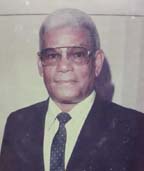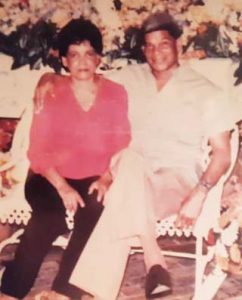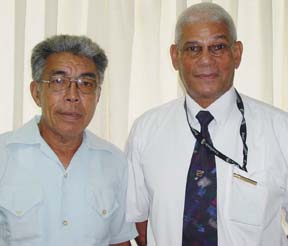Latest update March 31st, 2025 6:44 AM
Latest News
- ExxonM and CNOOC sticking to 11B barrels figure in Stabroek Block, but Hess says estimate higher
- Deadly Israeli strikes mar Gaza Eid celebrations
- Govt. to roll out automated speed ticketing system next week
- Bandits push down guard, rob Chinese nationals of over $1M in cash, other items
- Omai increases gold pit drilling
Charles Huston, a shaper of Guyana’s aviation sector, is a ‘Special Person’
Dec 23, 2018 Special Person
Pull quote: “I was sitting next to my brother, as a nine-year-old, when I saw an amphibious aircraft landing, and I told him I will be an engineer to fix that…”
By Staff Writer
A man with a dream cannot be denied! In 1949, a nine-year-old boy, who saw an amphibious aircraft landing at the Great Troolie Island, Essequibo River, became transfixed with the dream of one day being an aeronautical engineer. That little boy was Charles Hutson, who became a giant in the aviation sector.
While interviewing Hutson on his life’s work, it became clear why he is a ‘Special Person’. He has dedicated his entire life towards Guyana’s aviation sector. His contributions have paved the way for the creation of manuals guiding operations in the sector, and the functioning of The Art Williams and Harry Wendt Aeronautical Engineering School, among others.
“I was sitting next to my brother, as a nine-year-old, when I saw an amphibious aircraft landing, and I told him I will be an engineer to fix that…I repeated this desire before going to bed that night and received some lashes from my mother, who did not want me to depart from our traditional business – timber and farming,” Hutson said, as he struggled to hold back tears.
Perhaps it was this burning desire that led his parents, James and Alberta Hutson, to allow him to pursue his dream. In 1955, with the assistance of his mother, Hutson left the Great Troolie Island to attend the Government Technical Institute. This was the first step to a lifelong career in the aviation sector.
At just 21 years old, in September of 1961, Hutson joined the British Guiana Airways (known then as BG Airways), a Department of the Ministry of Communication and Works. The Ministry had advertised to train persons who were interested in pursuing studies to become Licensed Aircraft Engineers at an Institution in the United Kingdom (AIR WORKS Perth, Scotland). Being a part of the emerging aviation sector excited Huston.
“In 1968, I was awarded the R-985 engine licence and completed the airframe licence rating in 1969…That same year, the Ramp Operations were moved to Atkinson field now Timehri and we saw the coming of the Twin Otters… 1968 and 1989 was a very intense period for me with travel, work, type courses and licence examinations, as well as a call beyond the normal course of duty in support of the National Airline in its role in the Rupununi uprising, the New River Triangle incursion by Suriname and the Ankoko affair with Venezuela,” he said.
During his early years at the Ramp Ruimveldt (1963), Hutson was involved with the rebuild and inspection of 8R-GEU Certificate of Airworthiness. He gained significant experience in this area, which resulted in him, many years after, being capable of preparing documents on such matters.
Maybe one of the most difficult situations Hutson encountered during his early career was the crash of a Twin Otter 8R-GCP. Hutson, who was the Engineer in Charge of the Station, related that the Guyana Airways Corporation had constructed a new Hangar shortly after the Ramp Operations moved to Timehri, 1971-1972. It had opened an Operation at Ogle, where the Twin Otter was moved and operated exclusively. During the dreadful accident, the aircraft was being captained by pilot Walter Dhanraj and co-pilot Watson, who did not survive. However, the third crew member, a Mr. Da Silva, miraculously survived the crash and ensuing days in the jungle before being rescued.
Hutson sadly recounted, “This episode was not my first loss of equipment, but it was certainly my first experience with the loss of life by accident through equipment for which I had been the Engineer releasing to service…I learnt very early that no words will ever be enough to offer to grieving wives, mothers and, especially children, who have lost their father and loved ones…If nothing else, I resolved, and indeed that experience strengthened my resolve and commitment to excellence; no tolerance for excuses for not doing a job to the best of my ability, and an unswerving commitment to remain in Guyana and contribute to the development of my fellow Guyanese.”
Hutson found himself growing with the aviation sector that was making significant strides to expand. The British Guiana Airways by this time had in place a training programme to have its aircraft flown by Guyanese nationals to gain experience and eventually take over the leadership of the existing fleet and new additions.
He reflected that many engineers enhanced their trade and mastery in aircraft handling and flight characteristics outside of the textbooks, which by and large were extremely rare, and difficult to come by. Indeed, test flights both for Certificate Renewal and in reestablishing the functionality of replaced major components, added to their experience in clearing defects, and improved immeasurably, their interaction with flying crews.
At the beginning of 1976, Hutson was seconded to the Army, along with Harcourt Browman, Planning and Administrative Engineer at GAC, to develop the Army Air Corps aviation capability. His years of experience in aviation were recognized by the late Forbes Burnham.
“In the beginning of 1975, I was sent to France along with Mr. George Loy for a year, to undergo training on the SA319B helicopter, both at the Engine Factory (Turbomecca) in Bayonne and the airframe Factory (Aerospatiale) in Marseille…On my return in late 1975, I was made Superintendent for Helicopter Maintenance’ and in early 1976 was seconded to the Air Corps Guyana Defence Force,” he said.
At the GDF Air Corps, Hutson focused mainly on developing the Engineering capability of the Army so that it emerged quite self-sufficient, capable of undertaking the many maintenance tasks that it was called upon to execute. Many young persons were afforded both OJT and overseas training, so that on his return to the Guyana Airways Corporation in early August of 1988, the Corps remained strong.
In September 1988, he joined Trans Guyana Airways in the post of Assistant General Manager to Mr. Christopher Correia. Trans Guyana Airways operated a fleet of three Islanders and one Cessna 185 on floats.
The Operators at the time he started working at Ogle for were Trans Guyana Airways – owned by the Correia Family, Air Services Limited – owned by A. Mazaharally and Sons, Kayman Sankar Ltd. owned by the Kayman Sankar family, GuySuCo – (Aircraft Department) Government Corporation, and Wings Aviation Limited (owned by Ronald and Roxanne Reece).
“The private aircraft operators were quite a hardy breed whose contribution to the continued development of the Interior can never be understated, where in time they became the lifeblood to the inhabitants of the interior and mining activities, when the National Airline ceased its Operations in the early 1990s,” Huston said.
He noted that the expanding aviation sector locally, alarmed the CAA (UK) Office in Trinidad during the 1988 period. Guyana was told of the Office’s intention to withdraw support to the Civil Aviation Department and the inspection service that they were providing to Guyana. This provided the opportunity for the strengthening of the local sector. It also meant job opportunities for Guyanese.
Notable help and assistance came from an unexpected quarter in the person of Capt. Malcolm Chan-A- Sue. In fact, the Art Williams and Harry Wendt Aeronautical Engineering School was conceived by Capt. Chan-a-Sue, A.A., M.S. and Col. Charles Hutson, and began operating in 1993.
“Although a career pilot, Malcolm, perhaps arising from his early responsibility as Chief pilot of Guyana Airways and interaction with Engineering, started showing great interest in what was developing at Ogle, and in his own inimitable style arrived on the scene with suggestions and help at the most appropriate juncture in the struggle to get the Organisation on its footing,” he said.
It was at this juncture that Hutson realized that the dream of the nine-year-old boy had evolved from just fixing aircraft to fixing a sector. He was given the opportunity to contribute in a meaningful way. He had the opportunity to pave the way for the training of mechanics from the basics, establishing training records, equipping them with the theoretical knowledge and confidence to face an examination to meet the grades set for the Organisation.
“This is the background from which the first Maintenance Exposition commenced, putting on paper a vision of an Approved Maintenance Organisation, the dream of a few of us who, remained in Guyana, and who had been nurtured in our bosom for a long time. It also was born out of a desire to have our own people equipped to be able to handle any maintenance challenge,” he said.
He recalled, “The local DCA Office was not equipped to give much guidance; in fact very little advice could have come from that office, as it was not equipped with its own Engineering personnel. The office in its own way helped, and in conjunction with the visiting surveyors was gradually moving to participate in this activity as well as to reorganize itself to embrace the new reality that was coming…We spent a full two weeks or more at the Correia Family Business Head Office in Charlotte Street, flushing out the Manual in detail…The final document consisted of over 250 pages.”
He noted that it was this ongoing thrust to gain approval and development of the organisational skills that resulted in Chan-A-Sue obtaining help through the Good Offices of the British High Commission to secure the services of an experienced aircraft engineer who had spent quite a number of years as an instructor, working with British Executive Services Overseas (BESO).
The School holds approvals from the Regional Airworthiness Bodies along with ISO Certifications. To understand this development, one has to recognize that in order to embrace the level we aimed for in Caribbean Helicopters Limited (CHL) and later now, Caribbean Maintenance Services Limited (CAMS) the training Institution is an integral part for the continued approval status of the Aircraft Maintenance Organisation (AMO).
Hutson served the CAMS until 2001 when he had reached the retirement age limit of the Correia Group of Companies. During that period saw the introduction of turbine-powered aircraft introduced at Ogle – firstly, the Shorts Skyvan and secondly, the Cessna Caravan C208B which has become the flag carrier not only for Trans Guyana Airways, but the other operators, notably Air Services Limited, whose fleet has increased dramatically.
Today, Hutson is the Chief Technical Officer of Orinduik Development, a company that is establishing a heliport at Lusignan.
Share this:
- Click to print (Opens in new window)
- Click to email a link to a friend (Opens in new window)
- Click to share on Facebook (Opens in new window)
- Click to share on WhatsApp (Opens in new window)
- Click to share on Twitter (Opens in new window)
- Click to share on Pinterest (Opens in new window)
- Click to share on Pocket (Opens in new window)
- Click to share on Tumblr (Opens in new window)
- Click to share on Reddit (Opens in new window)
- Click to share on LinkedIn (Opens in new window)
Related
Similar Articles

The Glenn Lall Show|| March, 28th, 2025
Follow on Tik Tok @Glennlall
THE BLUNT OF THE DAY

Sports
Mar 31, 2025
-as Santa Rosa finish atop of Group ‘B’ Kaieteur Sports- Five thrilling matches concluded the third-round stage of the 2025 Milo/Massy Boys’ Under-18 Football Tournament yesterday at the...Features/Columnists
Choosing between bad and worse
Peeping Tom… Kaieteur News- I’ve always had an aversion to elections, which I suppose is natural for someone who... more
The U.S. “Joining” the Commonwealth: an unreasonable expectation
By Sir Ronald Sanders Kaieteur News- Recent media stories have suggested that King Charles III could “invite” the United... more
Publisher’s Note
Freedom of speech is our core value at Kaieteur News. If the letter/e-mail you sent was not published, and you believe that its contents were not libellous, let us know, please contact us by phone or email.
Feel free to send us your comments and/or criticisms.
Contact: 624-6456; 225-8452; 225-8458; 225-8463; 225-8465; 225-8473 or 225-8491.
Or by Email: [email protected] / [email protected]
Weekend Cartoon

















